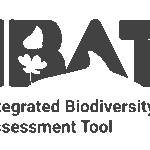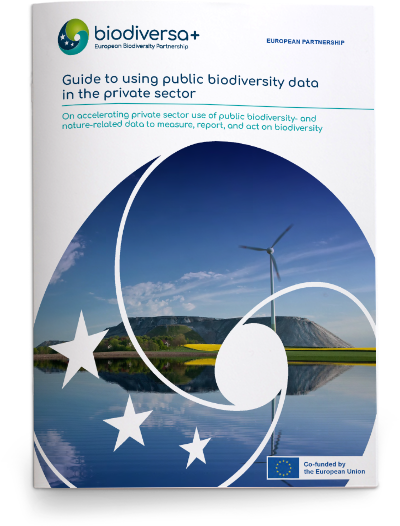“Guide to using public biodiversity data in the private sector”
Published: October 2025 | DOI: 10.5281/zenodo.16967409
Over half of global GDP depends on ecosystem services. As regulations like CSRD and TNFD take hold, businesses are under pressure to make biodiversity a measurable part of their decisions. Yet many still struggle, citing a lack of usable biodiversity data.
In reality, vast biodiversity and nature-related datasets already exist, hosted by research institutions, government agencies, NGOs, citizen scientists and even private companies. GBIF alone hosts records of more than 1.6 million species gathered over three centuries. The challenge isn’t scarcity, but accessibility: knowing where to look, what to trust, and how to use it.
This guide helps bridge that gap. It explains how to find, assess and apply public biodiversity data responsibly, offering:
- An overview of key public data sources and what they contain
- Guidance for evaluating data quality, resolution and relevance
- Solutions to common challenges like licences, sensitive data and comparability
- Workflows and a 5‑step checklist for responsible data use
- Real‑world case studies showing how businesses have turned data into action
The guide is aimed at:
Businesses integrating biodiversity into operations, strategy or reporting
Takeaways?
- Start now: Work with available datasets to build internal capabilities and familiarity.
- Integrate early: Embed biodiversity data into procurement, investment, and site planning processes from the start.
- Collaborate: Work with intermediaries to tailor tools and provide feedback to data providers.
Financial institutions evaluating nature‑related risks and opportunities
Takeaways?
- Assess portfolio risks: Use public data and tools like ENCORE to screen investments for nature-related dependencies and impacts.
- Engage companies: Use data insights to engage portfolio companies on their biodiversity performance and strategy.
- Align reporting: Prepare for disclosure requirements under SFDR and CSRD by leveraging available data.
Policymakers shaping incentives to accelerate corporate use of public biodiversity data
Takeaways?
- Invest long-term: Fund the maintenance and improvement of core public biodiversity datasets as critical infrastructure.
- Support monitoring: Establish regional monitoring centres and long-term observatories to fill data gaps.
- Provide guidance: Develop reference datasets that align with regulatory frameworks like CSRD.
Data providers and intermediaries making biodiversity data more relevant and usable
Takeaways?
- Be transparent: Clearly document methodologies, licensing terms, and data lineage to build user trust.
- Standardise: Align tools with international frameworks like TNFD, SBTN, and GRI to enhance consistency.
- Educate: Provide training, use cases, and sector-specific guidance to accelerate responsible data use.
Standard-setting & reporting bodies aligning data requirements and definitions across frameworks.
Takeaways?
- Clarify expectations: Define data requirements under disclosure frameworks to reduce uncertainty.
- Align definitions: Agree on core metrics and taxonomies for concepts like ecosystem condition and species risk.
- Encourage integration: Promote the use of public data in reporting platforms and audit workflows.
Understanding the basics
What is biodiversity: The variability among living organisms from all sources—including terrestrial, marine, and aquatic ecosystems. It covers diversity within species (genetic), between species, and of ecosystems.
Dependencies (outside-in): The ecosystem services an organisation relies on to function. For example, agriculture depends on healthy soils, clean water, and pollinators.
Impacts (inside-out): Changes to the state of nature resulting from an organisation’s activities. These can be direct (e.g., land conversion) or indirect (e.g., supply chain pollution).
Risks & opportunities: Dependencies and impacts translate into financial risks (e.g., operational disruption, regulatory penalties) and opportunities (e.g., sustainable innovation, access to green finance).
The importance of location: Nature-related risks and opportunities are location-specific. Spatially explicit data is critical for identifying sensitive ecosystems and guiding appropriate business responses.
From raw observations to actionable insights, understand the key players in the data value chain:
Raw data collectors
Scientific institutions, NGOs, governments, private sector, local and Indigenous knowledge holders
↓
Data aggregators
GBIF, OBIS, national platforms, regional monitoring networks
↓
Data intermediaries
Tools, dashboards, metrics (IBAT, ENCORE, WWF Biodiversity Risk Filter)
↓
Private sector users
Companies & financial institutions making strategic and operational decisions
Why the gap exists ?
ESG & Reporting
Use public data to inform double materiality assessments, provide context for site-level risks, and populate indicators for ESRS/TNFD reporting.
Tip: document which datasets and versions you used; it improves auditability and reproducibility.
Supply-chain screening
Map supplier regions against public pressure layers (forest loss, protected areas) to prioritise engagement and sourcing changes.
Tip: combine coarse public layers with targeted local surveys where precision is needed.
Site selection & permitting
Early use of species occurrences, habitat maps and EO data reduces permitting delays and identifies mitigation hotspots.
Tip: check licence conditions and sensitive-species guidance before publicising exact locations.
Innovation & product design
Open data can support nature-positive product features, biodiversity-linked financial products, or ecosystem-service valuation models.
Tip: collaborate with data intermediaries to convert raw layers into business-ready indicators.
Below are some of the platforms most relevant to business needs.

The largest global database for species occurrence data. Essential for understanding species distribution and presence/absence in specific locations.

The leading global database for marine biodiversity data. Crucial for companies with coastal or offshore operations.

Provides satellite-based geospatial data on land cover, land use, vegetation state, and water cycles across Europe. Crucial for assessing habitat extent and change.

Provides access to key global datasets like the IUCN Red List, World Database on Protected Areas, and Key Biodiversity Areas. Ideal for site-level risk screening.

Helps financial institutions understand how economic sectors depend on and impact nature. Useful for portfolio-level analysis.

A free online tool that helps companies assess and prioritise biodiversity-related risks across their operations and value chains.
These are but a few examples. The guide discusses a broader set of portals, tools and intermediaries.
Challenges & solutions
Explore the common barriers to using biodiversity data and discover practical solutions for different stakeholders:
Core challenge:
Limited ecological literacy and a lack of shared language make biodiversity data challenging to apply in business contexts.
Implications for businesses:
- Difficulty aligning internal teams
- Limited confidence to act on biodiversity risks
- Fragmented ownership and unclear responsibilities
Suggested solutions
Private sector:
Offer cross-functional training and develop communities of practice.
Data intermediaries:
Curate tools by user profile and provide clear guidance.
Policymakers:
Support capacity-building initiatives.
Core challenge:
Public data often has gaps in resolution and coverage, unclear licensing, and is misaligned with specific business needs.
Implications for businesses:
- Data is not always suitable for site-level analysis
- Licensing uncertainties restrict reuse
- Hidden costs of cleaning and processing data
Suggested solutions
Private sector:
Adopt clear licensing, invest in data quality, and secure long-term funding.
Data intermediaries:
Co-finance critical datasets and define project-relevant needs.
Policymakers:
Enhance regional monitoring and embed funding in policy.
Core challenge:
Data is scattered across platforms with inconsistent standards, limited metadata, and unclear provenance, making it hard to compare and audit.
Implications for businesses:
- Difficult to compare datasets and indicators
- Uncertainty about data reliability and provenance
- Misalignment of baselines hinders robust target-setting
Suggested solutions
Private sector:
Adopt metadata standards and ensure data continuity.
Data intermediaries:
Standardise and centralise data, improve interoperability, and foster consensus on methods.
Policymakers:
Define clear objectives and use cases for data.
Core challenge:
Regulatory uncertainty about what data is acceptable for compliance, combined with a lack of assurance infrastructure, can hinder investment and action.
Implications for businesses:
- Difficulty demonstrating compliance with evolving regulations
- Uncertainty around audit readiness
- Limited incentives for strong biodiversity performance
Suggested solutions
Private sector:
Simplify regulatory guidance and promote harmonisation.
Data intermediaries:
Prepare for compliance and integrate biodiversity into corporate strategy.
Policymakers:
Build enabling infrastructure and harmonise regulations.
Core challenge:
Biodiversity data is often used too late in decision-making, and it is difficult to measure and attribute outcomes to business interventions.
Implications for businesses:
- Missed opportunities to address risks or create value
- Inconsistent or non-credible monitoring of actions
- Unclear ownership of biodiversity within business units
Suggested solutions
Private sector:
Facilitate secure data sharing and standardisation.
Data intermediaries:
Integrate data into early-stage planning and collaborate on landscape-level solutions.
Policymakers:
Collaborate with businesses to tailor data solutions.
The ACT-D framework: Your journey
Most private sector organisations follow a similar path when integrating biodiversity into decision-making. Understanding these phases helps clarify what data is needed at each point and what barriers you’ll encounter:
Identify where biodiversity risks, dependencies, and opportunities occur in your operations and value chains. Common issues include:
Internal teams are often unaware of existing public biodiversity datasets or platforms. The landscape is vast and fragmented (e.g., GBIF, OBIS, national platforms, regional initiatives) making it unclear where to start.
Public biodiversity data is unevenly distributed geographically and by ecosystem type. Marine, freshwater, and soil biodiversity are underrepresented compared to terrestrial species. Coverage varies dramatically by region.
Company asset registries, supply chain data, and operational information are structured differently from biodiversity datasets. Spatial resolution, classification systems, and geographic boundaries don’t align, making integration difficult.
Set goals, targets, and internal governance structures to formalise your commitment to managing biodiversity. Common issues include:
Public data often lacks historical depth, reference values, or clear definitions of what constitutes “healthy” or “degraded” ecosystems. Companies struggle to establish what a meaningful or credible target actually looks like.
Sustainability, operations, and finance teams use different terminology, metrics, and definitions. There is no common understanding of what biodiversity means for the business or how it should be measured and managed.
Integrate biodiversity into core operations, sourcing, and business models. Measure and report on effectiveness of interventions. Common issues include:
Monitoring whether business interventions actually improve biodiversity is challenging. Public datasets may lack sufficient spatial resolution, temporal continuity, or timeliness to detect meaningful ecological change. Long-term monitoring is costly and often inconsistent.
It is unclear how much observed ecological change can credibly be attributed to a company’s specific actions versus external factors or broader ecosystem dynamics.
Report performance, risks, and dependencies under regulatory and voluntary frameworks to external stakeholders. Common issues include:
Regulatory frameworks (CSRD, TNFD, SBTN, CSDDD) are emerging with different requirements, timelines, and interpretations. Companies struggle to know what data and methodologies are considered acceptable for compliance, and what constitutes “decision-useful” information.
Companies use different indicators, spatial boundaries, assumptions, and methodologies. This makes external comparisons, benchmarking, and credibility assessment difficult.
Ready to start using biodiversity data?
The full guide includes detailed frameworks, real-world use cases from frontrunner companies (Enedis, Philips, Allianz, ASN Bank, Wallenius Wilhelmsen), practical data sources and tools, and specific recommendations for different organisational roles.
Complementary resource: This guide focuses on using public biodiversity data. If your company is also collecting biodiversity data, see our companion guide on best practices for sharing biodiversity data. Sharing strengthens the collective knowledge base and can generate competitive advantage for your organisation!
